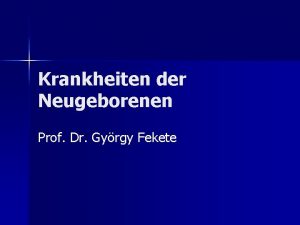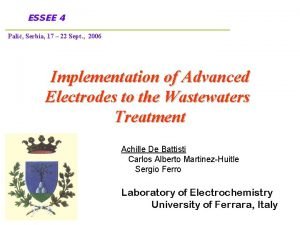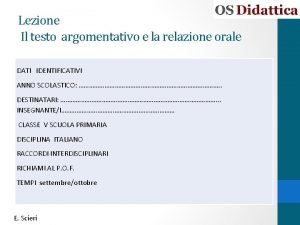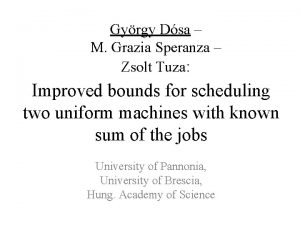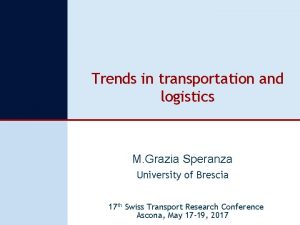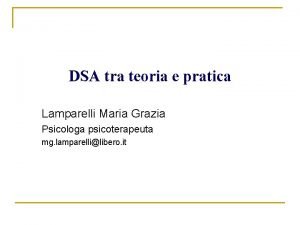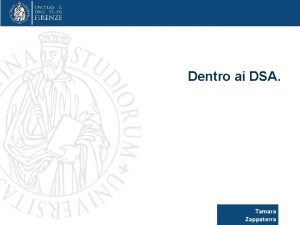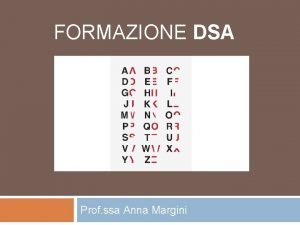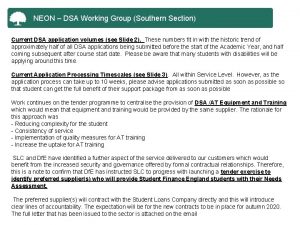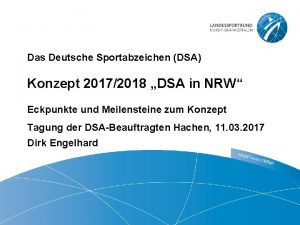Gyrgy Dsa M Grazia Speranza Zsolt Tuza Improved







![previous work: [1] Kellerer, Kotov, Speranza, Tuza: Semi online algorithms for the partition problem, previous work: [1] Kellerer, Kotov, Speranza, Tuza: Semi online algorithms for the partition problem,](https://slidetodoc.com/presentation_image/d373859bb5ab7f82483b9b37636fff9d/image-8.jpg)
![case of 2 uniform machines, [2] Angelelli, Speranza, Tuza: known sum: Semi online scheduling case of 2 uniform machines, [2] Angelelli, Speranza, Tuza: known sum: Semi online scheduling](https://slidetodoc.com/presentation_image/d373859bb5ab7f82483b9b37636fff9d/image-9.jpg)
![Previous (lower and upper) bounds from [2] these two intervals remained to be investigated Previous (lower and upper) bounds from [2] these two intervals remained to be investigated](https://slidetodoc.com/presentation_image/d373859bb5ab7f82483b9b37636fff9d/image-10.jpg)











- Slides: 21

György Dósa – M. Grazia Speranza – Zsolt Tuza: Improved bounds for scheduling two uniform machines with known sum of the jobs University of Pannonia, University of Brescia, Hung. Academy of Science

Scheduling: some kind of combinatorial optimization We use three-field notation: α ׀ β ׀ γ, where α : machines: parallel, uniform (processing time is pi/s), … β : jobs: precedence constraints, release dates, due dates, preemption is allowed or not, … γ : objectives: makespan, (weighted) sum of completion times of jobs, number of not completed jobs, … (many practical applications, interesting, hard problems, …)

just an example: P 4 ׀׀ Cmax , i. e. • identical parallel machines, Cmax • no restrictions on jobs, • minimizing the maximum J 6 s J 1 6 J 2 M 1 M 2 J 3 3 M 3 J 5 compl. time (makespan) = Cmax J 4 • load: sum of proc. times of jobs assigned to the machine M 4 • s = smallest load this schedule is made by List Scheduling (Graham, ‘ 66)

Competitiveness (performance ratio) • We compare the „goodness” of an algorithm A to an optimal algorithm OPT • How many times can be A worse than OPT in the „worst case”, i. e. C(A) = sup { A(I) / OPT(I) }, where I is an arbitrary input (instance) ( for example, C(LS)= 2 - 1/m )

Lower bounds • Adversary: a very wrong sequence, for what no algorithm can perform well • Similar to a Maker-Breaker game: Maker = adversary (building a big makespan) Breaker = algorithm (enforcing a small makespan) • Optimality: if the lower bound touches the competitive ratio (we are happy if our algorithm is optimal)

(some) recent, and popular topics: • • Scheduling with machine cost (J. Noga, Cs. Imreh) Randomization (can help? ) Rejection (we can reject the job, but must pay penalty) Semi online problems: we know something, but not everything about the jobs, (or we have a buffer, or…) What is Known: sum, largest size, a range of sizes, order of the jobs, … now we will deal with this condition

so our problem is now: Q 2 ׀ Sum = S ׀ Cmax • two related machines, • only the sum of the sizes is known • the makespan is minimized
![previous work 1 Kellerer Kotov Speranza Tuza Semi online algorithms for the partition problem previous work: [1] Kellerer, Kotov, Speranza, Tuza: Semi online algorithms for the partition problem,](https://slidetodoc.com/presentation_image/d373859bb5ab7f82483b9b37636fff9d/image-8.jpg)
previous work: [1] Kellerer, Kotov, Speranza, Tuza: Semi online algorithms for the partition problem, Op. Res. Letters 21 (1997) a many times cited paper the main results: - three semi online versions of P 2 II Cmax, - three optimal algorithms with the same comp. ratio C=4/3, ( the pure online comp. ratio is C=3/2 (LS) )
![case of 2 uniform machines 2 Angelelli Speranza Tuza known sum Semi online scheduling case of 2 uniform machines, [2] Angelelli, Speranza, Tuza: known sum: Semi online scheduling](https://slidetodoc.com/presentation_image/d373859bb5ab7f82483b9b37636fff9d/image-9.jpg)
case of 2 uniform machines, [2] Angelelli, Speranza, Tuza: known sum: Semi online scheduling on two uniform processors, Theor. Comp. Science 393 (2008), 211 -219. the paper provides: • three simple algorithms Q 2 ׀ Sum=S ׀ Cmax • lower bounds • optimality if s=1, and in two intervals (not everywhere opt. , or not proved to be opt. )
![Previous lower and upper bounds from 2 these two intervals remained to be investigated Previous (lower and upper) bounds from [2] these two intervals remained to be investigated](https://slidetodoc.com/presentation_image/d373859bb5ab7f82483b9b37636fff9d/image-10.jpg)
Previous (lower and upper) bounds from [2] these two intervals remained to be investigated better, where previous algorithms are not (or not proved to be) optimal

The case of the first interval: 1 < s < 1. 28 we have optimal algorithms for almost the whole interval

in the case of the first interval • the problem is solved by a „ladder” algoritm, (we will define it a little bit later) • only two „steps” are enough to get optimal ratio • the case of the other interval seems to be more difficult: - we still get optimal ratio for some subintervals - more steps are needed - we will show the results only for s=1. 5

lower the present results for s=1. 5: 1. 333 15/11=1. 3636 lower improved bounds upper 1. 4 Coal. Bas(1): 1. 4 (original) U Coal. Bas(2): 1. 3846 (better) P Coal. Bas(3): 1. 375 (better) P Coal. Bas(4): 1. 3721 (better) E Coal. Bas(5): 1. 3718 (better) R Coal. Bas(6): 1. 3714 (better) Coal. Bas(7): 1. 3715 (worse) (for further k? OPT = ? in case of other s? open questions)

How does an adversary work? (how to get 15/11) Suppose SUM=11+16. 5, we want to get loads 15 and 22. 5 resp. 15 22. 5 safe sets 11 S 0 (at least) Let J 1=1 if J 1 goes to M 2: 16. 5 12. 5 J 2=5 if J 2 goes to M 1: J 3=10, J 4=11. 5 5 4 6 s=1. 5 if J 2 goes to M 2: J 1 J 3=16. 5, J 4=5 in both cases: OPT=11, C ≥ 15, OK.

(how to get 15/11, 15 22. 5 safe sets 11 S 0 PART II) We conclude: J 1 goes to M 1. Let J 2 = 2. 5 if J 2 goes to M 1: 16. 5 12. 5 J 3=11. 5 if J 3 goes to M 1: J 4=11, J 5=1. 5 5 4 6 if J 3 goes to M 2: J 2 s=1. 5 J 1 J 4=12. 5 in both cases: C/OPT ≥ 15/11, OK.

(how to get 15/11, 15 22. 5 safe sets 11 S 0 16. 5 12. 5 5 4 6 J 3=4 J 1=1 J 2=2. 5 s=1. 5 PART III) We conclude: J 2 goes to M 2. Let J 3 = 4 if J 3 goes to M 2: J 4=16. 5 then: OPT=11, C ≥ 15, OK. We conclude: J 3 goes to M 1. *****THEN******* the last two jobs are J 4 = J 5 = 10, and OK.

the improved algorithm: Coal. Bas(k) = Climbing On A Ladder, (a basic alg. ) with step K 14 21 safe sets 10 S 1 S 0 The previous alg. would be Coal. Bas(1), since the safe sets are S 0 and S 1 (no more) 15 11 • Assign the job to M 1 until we reach S 1. • If we jump over S 1, then Ji >10 must hold. Assign the job to M 2. If we reach S 0: OK 4 • Otherwise: Assign again to M 1 until we reach S 1. • If we jump over again: s=1. 5 (No problem, since two big jobs, opt >10, …)

the idea : by one more safe set: we get Coal. Bas(2), and C=36/26=1. 3846 < 1. 4 36 54 • Assign to M 2 while L 2 < 4 • If S 2 is reached: 26 S 1 S 0 39 - assign the next jobs to M 1 while L 1<11. - if S 1 is reached: OK (further jobs go to M 2) 29 - if the next job would jump over S 1: it is > 25 -assign it to M 2 11 15 S 2 s=1. 5 4 -if we reach S 0: OK (further jobs go to M 1) -if we jump over S 0: OK (further jobs go to M 1) • If S 2 is jumped over: the job is > 11, and so on…

How to define the safe sets? • we ensure that the proof will be correct • a simple recursion is applied • a better way? - If we get valid safe sets (nonnegative top and bottom, non overlapping safe sets) then this recursion is the best choice • what is the best choice of the safe sets if the recursion fails? • what is the best choice of parameter K?

Coal. Bas(3), 66 99 48 72 S 1 S 0 54 21 27 12 S 3 S 2 3 s=1. 5 9 Coal. Bas(4): • the algorithm is similar, • can be made in a recursive way • for bigger K it is a little bit more difficult, • also the proof 66/48 = 1. 375 118/86 = 1. 3721 118 177 86 129 S 1 S 0 97 38 48 21 S 3 S 2 17 7 S 4 10 3 s=1. 5

• Coal. Bas(6): the best we can do in this way for s=1. 5 the best upper bound is 1. 3714 • • the lower bound is 1. 3636 Further improvements? Case of other s speeds? Better lower bound? (many open questions) Thank You for your kind attention!
 Grazia speranza
Grazia speranza Gyrgy
Gyrgy Caput succedaneum vs kephalhämatom
Caput succedaneum vs kephalhämatom Parrocchia pavoniana brescia
Parrocchia pavoniana brescia Chiara speranza
Chiara speranza Per me l'ago della bilancia sei sempre tu
Per me l'ago della bilancia sei sempre tu Nel 1488 diaz supera il
Nel 1488 diaz supera il Bartolomeo diaz supera il capo di buona speranza
Bartolomeo diaz supera il capo di buona speranza Avvento tempo di attesa e di speranza
Avvento tempo di attesa e di speranza Continuerò a credere anche se tutti perdono la speranza
Continuerò a credere anche se tutti perdono la speranza Dsa algorithm
Dsa algorithm Aufmerksamkeit dsa
Aufmerksamkeit dsa Dsa large letter
Dsa large letter Segnali predittivi dsa scuola infanzia
Segnali predittivi dsa scuola infanzia Rsa signature
Rsa signature Direct school admission
Direct school admission Transpozitie de vase mari corectata anatomic
Transpozitie de vase mari corectata anatomic Dsa code
Dsa code Supermappe
Supermappe Differenza tra dsa e bes
Differenza tra dsa e bes Dsa anodes
Dsa anodes Mappa testo espositivo
Mappa testo espositivo

